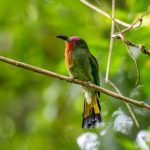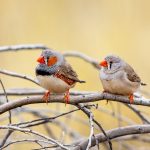We’ve been writing about holiday gifts for birders all week, but at the end of the day, what bird watchers really want is to be able to watch birds. Today, the Core Team joined members of the Hudson River Audubon Society for a fantastic bird walk at Croton Point Park in northern Westchester County. Thanks to the expert guidance of Michael Bochnik, we all enjoyed a superior day of birding, with old favorites, new sightings and an unexpected visitor from the Great North.
The group spotted more than 30 different birds. Let’s get the more common birds out of the way; we saw American Crow, Canada Goose, Mallard, Double-crested Cormorant, Northern Cardinal, Blue Jay, American Robin, American Goldfinch, Tufted Titmouse, Black-capped Chickadee, Brown-headed Cowbird, Downy Woodpecker, Red-bellied Woodpecker, and Cedar Waxwing. We also saw plenty of different species of sparrow: House, Song, Chipping, White-throated, and a new one for us, the American Tree Sparrow. A few weeks ago, we spotted our first Ruby-crowned Kinglet; today, we added its cousin, the Golden-crowned Kinglet.
The lifers didn’t stop there. We expected to see Bald Eagle, Red-tailed Hawk, and Northern Harrier, but we didn’t anticipate spotting an immature male Merlin. In the same vein, White-breasted Nuthatch was not surprising, but large numbers of Brown Creeper and Red-breasted Nuthatch (lifer) surely were.
Croton Point is a Hudson River delta. There was once a landfill here which has been capped and allowed to grow over. The resulting grassland, a really beautiful ecosystem, is attractive to sparrows and American Pipits. The pipits flew overhead in noisy flocks and actually landed in the short grass long enough for the group to deploy a couple of scopes. Nothing improves the quality of a birding trip more than spotting scopes (and people to carry them!) We were also surprised to see an Eastern Meadowlark, no doubt attracted to this prairie on the Point. This was our first U.S. view of the meadowlark.
The meadowlark wasn’t the only surprise today. While looking for ducks in the bay, we spotted a white bird in the distance that we presumed to be a Mute Swan. Further examination with binoculars and scopes indicates that this was no mute, but in fact a Tundra Swan. We wanted to be sure of this identification because Tundra Swan are extremely rare in New York. In summer, these birds breed in the Canadian Arctic and in Alaska. The eastern Tundra Swan population winters on the Atlantic Coast in Chesapeake Bay, in Maryland, and in North Carolina, but they hardly ever set down in the Hudson River. However, the straightness of this bird’s neck, as well as the color and shape of the beak confirmed our initial suspicion. The Hudson River Audubon Society walked away with a rarity!













Leave a Comment